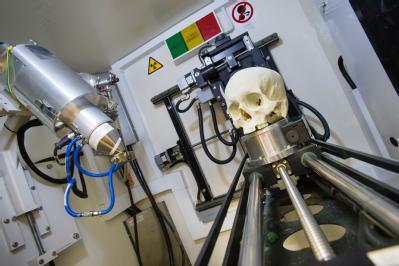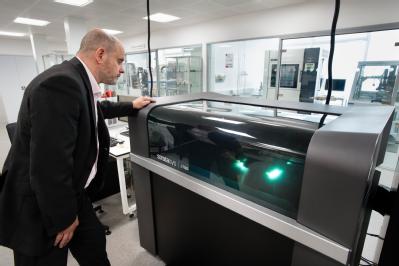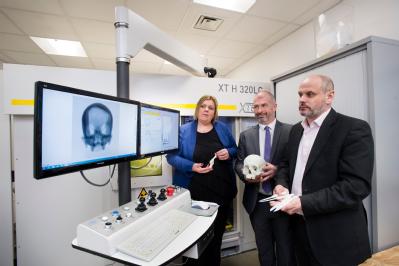New forensic centre to support police investigating homicide
· WMG Forensic Centre for Digital Scanning and 3D printing – a research hub supporting Homicide Investigation, has secured funding from West Midlands police to collaborate with them in the future
· High resolution X-ray scanner and 3D imaging technology provides images 1000’s times of the detail of a hospital scan
· The scans pick up microscopic injuries to support Home Office Pathologists in helping to establish cause of death
· Detailed visual renderings and 3D prints are made to be shown in trials to add visual context to expert testimony
WMG at the University of Warwick has secured investment from West Midlands Police for the WMG Forensic Centre for Digital Scanning and 3D printing – a research hub supporting Homicide Investigation. Where they can scan and reproduce 3D prints of injuries to bones to help in court testimonies.
The new WMG Forensic Centre for Digital Scanning and 3D printing – a research hub supporting Homicide Investigation has secured investment from West Midlands police to scan injuries and produce 3D print outs for use in expert testimonies.
The scans are 1000 times more detailed than hospital scans, and can detect microscopic injuries which could otherwise be missed by conventional medical CT scanners. 3D renderings are then produced of the injuries, and their age can be identified too. The renderings are used in court to during trials to provide visual context and support the Pathologist’s testimony.
Facilities at WMG, University of Warwick, have been used to provide expert witness testimony in over 100 Homicide cases by 13 different police forces across the UK. Cases include strangulation, stabbing, blunt force trauma and bone fractures.
A recent case study is the manslaughter of 9-week-old baby Teri-Rae.
Researchers at WMG used the high resolution X-ray (micro-CT) scanner, to scan the toddler’s ribcage. They were able to detect microscopic injuries which could otherwise have been missed by medical CT scanners. The evidence produced helped reveal a total of eleven injuries of varying ages. 3D renderings of these injuries were shown during trial to support the bone specialist’s expert testimony.
Professor Mark Williams of WMG comments:
“It is a real privilege to be able to support West Midlands Police and formalise our relationship through the establishment of a research centre. The opportunity to apply state-of-the technology to support Homicide investigation is very exciting.
3D X-Ray scanners allowed us to identify multiple fractures to Teri-Rae’s ribs that had occurred over an extended period of time. The ability to produce highly detailed 3D images of these shocking injuries that could be presented at court helped establish the truth and show what had happened. It’s an honour for us to provide critical evidence in cases like this, and to be able to help the police investigate such an unfortunate tragedy.”
The technology itself has been used beyond the West Midlands, with police forces throughout the United Kingdom using the technology as part of their investigations.
Assistant Director Michelle Painter Head of Forensic Services for West Midlands Police comments:
“The strategic partnership with WMG has enabled police forensics to access state of the art technology to progress investigations. In addition to the homicide cases being delivered through the centre, we are pushing research boundaries; combining scientific skill, knowledge and history with innovative technology and presentation techniques.
“Additional PhD studies have commenced on dismemberment tools and we will soon be finalising further research projects including scanning fingerprint and footwear marks and assessing damaged digital devices for protected data sources. The research and partnership possibilities are endless and exciting!”
West Midlands Police Detective Chief Superintendent Mark Payne, comments:
“I’m delighted West Midlands Police has been able to provide funding to sustain and develop the fantastic collaboration between us and WMG.
“We’ve been working with the team for several years now and their advanced 3D scanning technology has proved crucial in helping us uncover the truth behind some of our most serious crimes. It has undoubtedly played a key role in convicting killers and helped us better understand the circumstances surrounding other deaths.
“It’s vital UK policing is innovative in its use of technology and embraces academic developments…this is a pioneering partnership with WMG and one that puts us at the forefront of police forensics.”
ENDS
30 APRIL 2019
NOTES TO EDITORS
Image available at:
https://warwick.ac.uk/services/communications/medialibrary/images/april2019/wmg_280219-89.jpg Caption: The scanning machine at WMG, University of Warwick. Credit to WMG, University of Warwick
https://warwick.ac.uk/services/communications/medialibrary/images/may2019/d2978-23.jpg
Caption: A 3D printed skull in the micro-CT scanner. Credit to WMG, University of Warwick
https://warwick.ac.uk/services/communications/medialibrary/images/may2019/d2978-23.jpg
Caption: A 3D printed skull in the micro-CT scanner. Credit to WMG, University of Warwick
https://warwick.ac.uk/services/communications/medialibrary/images/may2019/d2978-16.jpg
A group shot of academics from WMG at the University of Warwick and West Midlands Police. Credit to WMG, University of Warwick
https://warwick.ac.uk/services/communications/medialibrary/images/may2019/d2978-32.jpg
Academic Guillaume Remy from WMG, University of Warwick demonstrating the micro-CT scanner. Credit to WMG, University of Warwick
https://warwick.ac.uk/services/communications/medialibrary/images/may2019/d2978-64.jpg
From left to right, Assistant Director Michelle Painter Head of Forensic Services for West Midlands Police and Detective Chief Superintendent Mark Payne and WMG Professor Mark Williams. Credit to WMG, University of Warwick
https://warwick.ac.uk/services/communications/medialibrary/images/may2019/d2978-48.jpg
From left to right, WMG Professor Mark Williams, Assistant Director Michelle Painter Head of Forensic Services for West Midlands Police and Detective Chief Superintendent Mark Payne. Credit to WMG, University of Warwick
https://warwick.ac.uk/services/communications/medialibrary/images/may2019/d2978-57.jpg
From left to right, WMG Professor Mark Williams, Assistant Director Michelle Painter Head of Forensic Services for West Midlands Police and Detective Chief Superintendent Mark Payne. Credit to WMG, University of Warwick
https://warwick.ac.uk/services/communications/medialibrary/images/may2019/d2978-8.jpg
Professor Mark Williams of WMG, University of Warwick looking at the 3D printer scans. Credit to WMG, University of Warwick
https://warwick.ac.uk/services/communications/medialibrary/images/may2019/d2978-73.jpg
Professor Mark Williams of WMG, University of Warwick looking at the 3D printer scans. Credit to WMG, University of Warwick
For further information please contact:
Alice Scott
Media Relations Manager – Science
University of Warwick
Tel: +44 (0) 2476 574 255 or +44 (0) 7920 531 221
E-mail: alice.j.scott@warwick.ac.uk
For further information please contact:
Alice Scott
Media Relations Manager – Science
University of Warwick
Tel: +44 (0) 2476 574 255 or +44 (0) 7920 531 221
E-mail: alice.j.scott@warwick.ac.uk
